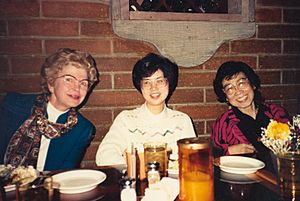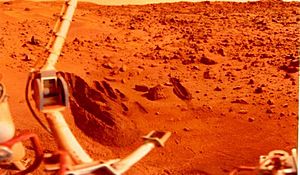Barbara Paulson facts for kids
Quick facts for kids
Barbara Paulson
|
|
|---|---|

(left to right) Paulson, Vickie Wang and Helen Ling, working at the Jet Propulsion Laboratory, socializing over lunch (1980)
|
|
| Born |
Barbara Jean Lewis
April 11, 1928 Columbus, Ohio, U.S.
|
| Died | February 26, 2023 (aged 94) Des Moines, Iowa, U.S.
|
| Occupation | JPL Human Computer, Engineer |
| Employer | Jet Propulsion Laboratory |
|
Notable work
|
Trajectory calculations for Explorer 1, Vikings 1 & 2, Voyagers 1 & 2, Mariner Probes |
| Spouse(s) | Harry Murray Paulson (1959-2003) |
| Children | Karen Bishop, Kathleen Knutson |
Barbara Jean Paulson (born Lewis; April 11, 1928 – February 26, 2023) was an amazing American scientist. She worked as a "human computer" at NASA's Jet Propulsion Laboratory (JPL). She was one of the first women scientists to work there.
Barbara started at JPL in 1948. She calculated rocket paths by hand, which was super important for early space missions. She helped make big steps forward in space exploration.
Contents
Early Life and Moving West
Barbara Jean Lewis was born in Columbus, Ohio, on April 11, 1928. She grew up with two older sisters and a younger brother. When she was 12, her father passed away.
From ninth grade, Barbara studied Latin and math. She didn't want to be a secretary like her sisters. After one year at Ohio State University, her sister, who lived in Pasadena, California, convinced their mom to move there. In 1947, her family moved to Pasadena. This is where Barbara's exciting career at JPL began.
In 1959, Barbara married Harry Murray Paulson in Pasadena. They lived there for a few years before moving to Monrovia. Later, in 1975, they settled in Glendora.
A Career Calculating Rocket Paths
Barbara Paulson joined the Jet Propulsion Laboratory in 1948. Her job was to be a "computer." This meant she calculated the exact paths for rockets. She worked on the MGM-5 Corporal, which was the first guided missile designed by the United States.
Barbara and her team even signed the 100th Corporal rocket before it went to a test range. On January 31, 1958, Barbara worked at the operations center for Explorer 1. This was the very first satellite launched by the United States during the Space Race with the Soviet Union. She did all this complex work with just a mechanical pencil, a light table, and graph paper. Her calculations helped the Corporal missile travel over 200 miles.
Facing Challenges at Work
In 1960, Barbara was expecting her first child. When she asked for a closer parking spot at work because she was pregnant, she had to leave her job. At that time, JPL did not employ pregnant women. There was no maternity leave, so women who left their jobs didn't have a way to return.
Luckily, Barbara's supervisor, Helen Ling, worked hard to help women return to JPL. In 1961, when her daughter was seven months old, Barbara accepted Helen's offer and came back to the lab. She didn't ask for a better parking spot when she was pregnant with her second child!
During her early years at JPL, there was even a beauty contest for the women "human computers." Barbara came in third place. The winner was called 'Miss Guided Missile'!
Exploring Space with Calculations
In the 1960s, after the success of Explorer 1, JPL started planning missions to the Moon and other planets. Barbara and her colleague Helen Ling worked extra hours. They calculated the paths for the Mariner probes that would go to Venus and Mars. They figured out that there were only short times when it was perfect to launch a probe from Earth to its target planet.
In the late 1960s, Barbara became an engineer and later a supervisor.
In the 1970s, Barbara played a huge role in the Viking program. This was the first mission to land on the surface of Mars! Barbara successfully calculated the path the Viking probe needed for its 11-month journey to Mars. Her calculations were also vital for the entry, descent, and landing (EDL) phase. This is when the lander separates, enters the Martian atmosphere, and parachutes down.
In the late 1970s, Barbara and her team worked on paths for the Voyager missions. Voyager 1, launched in 1977, is now the farthest human-made object from Earth.
Barbara retired from JPL in 1993. She stayed in Pasadena until 2003 before moving to Iowa.
Family Life
Barbara and her husband Harry had two daughters, Karen and Kathleen. They also had four grandchildren: Jonathan, Kyle, Harrison, and Corrine. Barbara's husband, Harry, was a real estate appraiser. When Barbara returned to work at JPL, Harry was able to change his schedule to help care for their children. Many other "human computers" with children also adjusted their schedules.
Barbara's husband, Harry Murray Paulson, passed away on July 9, 2003. They had been married for 44 years. After his death, Barbara sold her home and moved to Iowa in 2003 to be closer to her daughters and their families.
Barbara Paulson passed away in Des Moines, Iowa, on February 26, 2023. She was 94 years old.
Recognition and Legacy
In 1959, Barbara Paulson received a special pin for her 10 years of work at the Jet Propulsion Laboratory. She worked there for 45 years in total, retiring in 1993.
In 2016, a book called Rise of the Rocket Girls was written by Nathalia Holt. This book tells the story of Barbara Paulson and other amazing women who were early employees at NASA. Her work helped pave the way for future space exploration!


